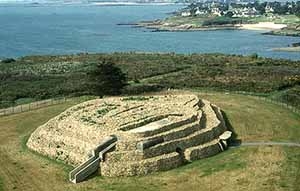- Home
- Megalithism in Morbihan
- Le Petit-Mont
- From the War of the Gauls to the Atlantic Wall
Sailors and archaeologists, soldiers and architects
Topped by its rounded cairn and reaching 36m at its highest point, the Petit-Mont headland was always an invaluable landmark for sailors.
- As early as the 16th century, Garcie Ferrande's Grand Routtier described "the next Morbihan headland eastwards, with a heap of stones on top of it".
- In 1636, Dubuisson-Aubenay referred to a "Beacon Hill" (which suggests that a beacon fire was kept burning on the monument at least occasionally).
- In 1825, Canon Mahé described the Petit-Mont "galgal" in Antiquités du Morbihan.
- In 1864-66, the first excavations were led by David de Cussé on the dolmen visible in the mound. But unfortunately, no report was published; a few notes and things were left at the Société Polymathique du Morbihan (local archeological society).
- In 1904, Le Rouzic resumed work on the site and had it listed. He came back to restore the dolmen in 1936.
- In 1943, a bunker and a firing post of the "Wall of the Atlantic " severely damaged the monument. The listed dolmen was seriously damaged, and so was another uncovered in the course of the work. A third was entirely destroyed.
- In 1979, J. Lecornec resumed the work which led to the restoration and display of this great monumental structure by the French Historical Monuments Authority.
- In 1990, the site - formerly local council property - was handed over to the Morbihan département council and its maintenance entrusted to the SAGEMOR, a public-private partnership.
Dolmen IIIa in Petit-Mont, during the 1904-1905 excavations, when the large slab (now destroyed) was found.
The cairn of Petit-Mont restored in its current state: the bunker which was built on the cairn in 1943 remains.
Caesar's shadow
Although the naval battle between Julius Caesar and the Gaulish tribe of the Venetes in 56 BC, which ended with the defeat of the latter, is known to have taken place between the Loire estuary and the Bay of Quiberon, its actual location has always been a matter of debate among local historians.
According to local tradition, both the great megalithic monuments of Tumiac and Petit-Mont lay claim to the name "Caesar's mound" and to the honour of having served as a panoramic viewpoint from which the conqueror of the Gauls followed the battle.

